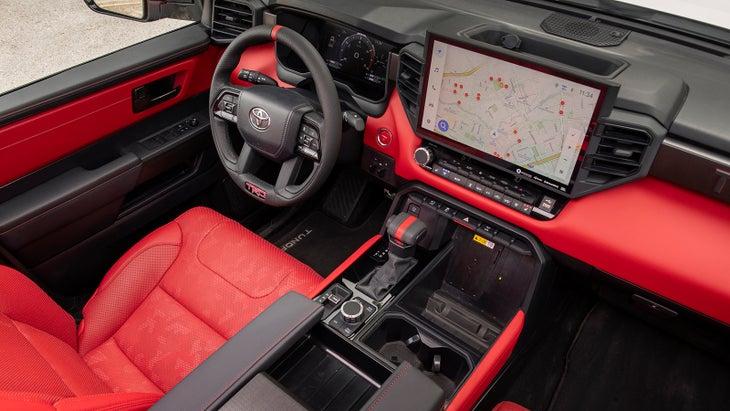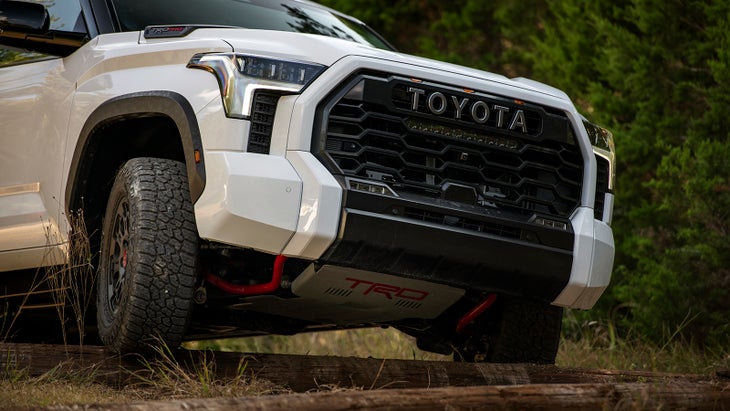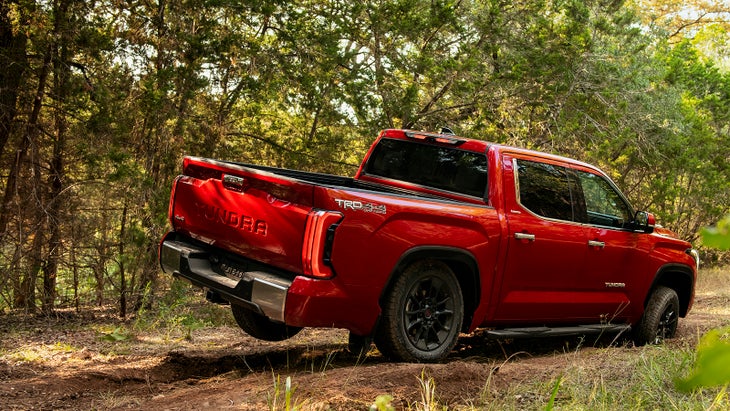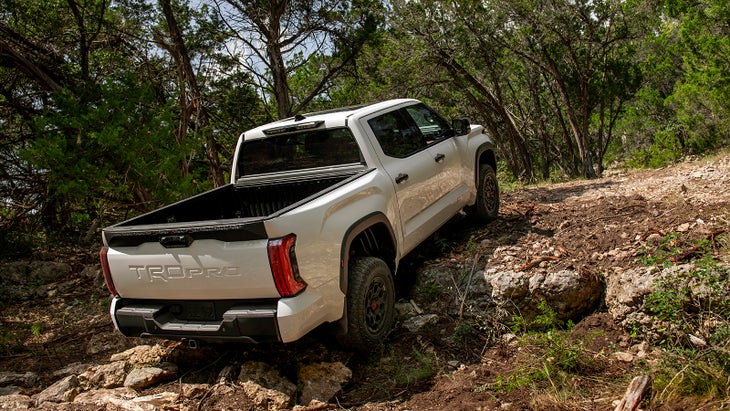Full-size pickup trucks are the multitools of the automotive world. They haul families and all their outdoor gear. They tow boats and trailers. And they can do all of that with equal aplomb whether they’re on-road or off. Full-size pickup trucks are also the best-selling type of vehicle in this country, and the most profitable, which makes the segment extremely competitive. With its first full redesign in 15 years, can the all-new 2022 Toyota Tundra go toe-to-toe with its domestic rivals? Last week, I flew to Texas to find out.
The old Tundra—first released in 2007—is perhaps the truck I recommend most to my readers. Essentially unchanged for 15 years, it fell behind the performance and technology offered by the latest Ford F-150, Dodge Ram, and Chevy Silverado. But skipping modern technology in favor of old and simple yet proven components made it easy to maintain, and that helped make used Tundras a reliable purchase for people on a budget. Going without substantial change for so many years also led to the wide availability of aftermarket parts, and a vast breadth of knowledge around modifying the truck to make it more capable off-road.
This all-new 2022 model sets out to bring the Tundra formula fully up-to-date.

The first area that needed improving was the powertrain. The big, simple 5.7-liter V8 in the old truck was plenty powerful, but only managed to return 14 miles per gallon in the Environmental Protection Agency’s combined test cycle. And its six-speed transmission just couldn’t match the responsiveness, refinement, or outright performance of its eight- and ten-speed rivals.
On the new truck, Toyota is fixing that with two new powertrain options. The base model is a twin-turbocharged, aluminum block V-6 that delivers 389 horsepower, and 479 pound-feet of torque, an improvement of five horsepower and 78 pound-feet one the old 5.7. The gasoline-electric hybrid version of the new Tundra, dubbed the “iForce Max” ups those numbers to 437 horsepower and 583 pound feet. Both versions are mated to a new ten-speed automatic transmission, complete with a two-speed transfer case.
The non-hybrid V6 improves not only performance, but also fuel economy. In the EPA’s test cycle, four-wheel drive versions will deliver 17 MPG in the city, 22 MPG on the highway, and 19 MPG combined. A 36 percent increase in fuel economy is significant and impressive. Toyota is not yet releasing fuel economy numbers for the hybrid Tundra, but says it should be even more efficient.
I drove both versions of the new Tundra in Texas last week, albeit for too short of a time to arrive at definitive conclusions about fuel economy. I can report that both versions feel significantly faster than the old truck, but also deliver smoother performance. The new ten-speed transmission is substantially more responsive.
All-electric rivals from Rivian and GMC use multiple electric motors to deliver power individually to each wheel or axle on those vehicles, while the gasoline-electric hybrid Tundra uses a single electric motor. Located in the bell housing between the engine and transmission (the hybrid’s battery is located under the rear seat), this arrangement requires no packaging compromises, and simplifies the driving experience.
At speeds up to 18 miles per hour, the hybrid Tundra can drive using only the electric motor. At higher speeds, or if the driver asks for more performance, both the electric motor and internal combustion engine will work together. Because this combined output still flows first through the ten-speed transmission, then the two-speed transfer case, on its way to the open front and optionally locking rear differentials, the driving experience remains completely traditional. Driving the hybrid, you won’t notice anything weird or clunky, or be asked to make any different control inputs, it just feels a lot faster than the non-hybrid version—because it is a lot faster.
This conventional drivetrain layout also carries advantages off-road. Early reports from journalists testing the Rivian R1T and GMC Hummer EV indicate that multi-motor EVs can, in some conditions, struggle to match the traction provided by conventional four-wheel drive layouts. The hybrid Tundra switches between two-wheel drive, four-high, and four-low conventionally, still locks the speeds of the front and rear axles together, and in TRD Off Road and TRD Pro trims, can lock the rear diff, too.
Those two TRD (Toyota Racing Development) trim levels promise to bring more off-road capability further down the new Tundra’s price structure. TRD Off Road will be available as an additional package buyers can add on top of any trim level from the mid-grade SR5, on up. It adds Toyota’s suite of electronic driver aids, that locking rear differential, and Bilstein shock absorbers. Toyota did not offer a factory-installed rear-locker on the previous Tundra, so that alone is a major upgrade.
TRD versions of the new Tundra also debut a new, much more sophisticated generation of Multi-Terrain Select (MTS) and Crawl Control. MTS is the brand’s electronic traction aid package, employing the anti-lock brake system to match wheel speeds in slippery conditions. Crawl Control adds a sort of off-road cruise control, taking control of the throttle and brakes to maintain a (very low) speed the driver selects, which leaves you free to focus on steering. Previous versions of these systems, as used on vehicles like my wife’s Land Cruiser, have been effective, but were behind rivals from Land Rover and Ford in terms of smoothness. This new iteration is a huge improvement; you’ll find it even more refined than those rivals, and want to use the systems much more often as a result.

TRD Pro adds a bunch of flashy appearance features, a very basic suspension upgrade made by Fox, and 33-inch Falken Wildpeak AT3W tires. TRD Pro will only be available on Tundras already equipped with the upmarket Limited trim, so while Toyota hasn’t yet released pricing for the new truck, it seems reasonable to conclude that TRD Pro will involve a substantial premium.
Compared to the old Tundra’s TRD Pro package, which provided a two-inch suspension lift, this new suspension only lifts the truck one inch. When combined with a new front sway bar that doesn’t disconnect, and is much stiffer than that used on the TRD Off Road, there are limits in articulation over large obstacles. I was unable to discern any difference in ride quality or damping between the TRD Off Road and the TRD Pro. I can’t tell you what the price difference will be between the two packages, but I can tell you whatever amount of money that ends up being, it will be better spent buying suspension from the aftermarket than it will from the Toyota dealer.
Another area where fans of the old Tundra are in for a surprise: inside the new truck. Toyota massively improved the interior on the new Tundra, adding space everywhere, and employing new, much higher quality materials. Dominating the new interior is an absolutely massive 14-inch centrally mounted touchscreen display. It’s visually stunning, incredibly useful, and features a host of new infotainment connectivity features. Toyota struck an ideal balance between deep functionality and ease of use with this system; it can be as simple and intuitive as you’d like, or as capable as you’re able to make use of.

The last big upgrade on the new Tundra comes from the rear suspension, with the old leaf springs replaced by a multi-link, coil-sprung rear axle. Better able to locate that axle precisely, throughout its range of motion, the new setup brings massive improvements to ride quality and handling on-road, but Toyota chose not to take advantage of the added articulation possible in the design. The Tundra, even in TRD Pro form, still lifts a rear wheel too easily over uneven obstacles. Forward progress remains possible when that happens, thanks to that optional rear locker, but this seems like a missed opportunity. The new Tundra is not discernibly more capable off-road than its predecessor.
Speaking at the launch, Toyota engineers clarified that they deliberately chose to prioritize on-road handling—especially when loaded down, or towing—rather than off-road articulation in the suspension’s design. Mounting the rear shocks outboard of the frame (opposite to the approach taken on more capable vehicles like the Land Cruiser), allows them to dial in more stability. But this does mean rear articulation falls behind that of the old Tundra.
All of that rounds out a very thorough and very impressive redesign. Compared to the old Tundra, the new Tundra is substantially faster, much more fuel efficient, and a lot nicer to drive. It’s also offers a much more comfortable cabin.
The only real problem the new Tundra has is that the rest of the truck market hasn’t stopped evolving in the last 15 years. The Dodge Ram has used a similar multi-link, coil-spring rear suspension arrangement since 2009. The Ford F-150 has been available as a gasoline-electric hybrid for the last year. And the Chevy Silverado did the whole squinty eye, gaping-jaw thing back in 2019.
Where the new Tundra provides only a standard 120 volt, 400 watt power outlet in its bed (basically just enough to recharge small gadgets), even in hybrid form, the new F-150 offers three in-bed power solutions, all of which best the Tundra. In basic form, Ford’s Pro Power Onboard system offers a 120 volt, 2,000 watt outlet on non-hybrid versions of the truck. Hybrid F-150s (24 MPG) come standard with a 120 volt, 2,400 watt outlet providing access to a 1.5 kilowatt-hour battery. An optional system provides a 240-volt, 30-amp, 7,200 watt outlet that’s powerful enough to run an entire construction site or power your home during an emergency.
I’ve seen some of our readers mistaking the new Tundra TRD Pro, with its coil rear springs, for an F-150 Raptor competitor. It’s not, competing more closely with the tamer F-150 Tremor, Dodge Ram Rebel, or Silverado ZR2. Although where the Tundra includes only an open front differential, failing to fully maximize traction, the Tremor offers a TorSen limited slip front diff, and the ZR2 provides a honest-to-goodness front locking diff.
But off-road capability and extreme quantities of electricity are features that may only be relevant to power users. It’s another, more mundane spec that I think even everyday drivers may find lacking on the Tundra, compared not to the truck it replaces, but to the trucks it’s supposed to rival: payload.

This is a number that Toyota has traditionally struggled with. Four-door, 4×4 Tacomas, for instance, provide only 1,125 pounds of payload, which limits safe modifications. And the previous Tundra’s 1,600-pound figure was also uncompetitive in its segment. Toyota deserves credit, though, for increasing the new Tundra’s maximum payload to 1,940 pounds (this number varies between trims, going as low as 1,600 pounds on the TRD Pro). But again, the problem isn’t necessarily in comparison to the old Tundra, it’s in comparison to other full-size trucks.
Maximum payload on a Dodge Ram 1500, which also has coil rear springs? Up to 2,322 pounds. The Chevy Silverado? Up to 2,310. And the Ford F-150, which offers an optional “Heavy Payload Package?” Up to 3,325 pounds.
I see a lot of people mistake payload for the amount of weight a truck is able to safely carry in its bed. Payload is actually the total weight a vehicle is able to carry, including fuel, passengers, and anything you might want to bolt to, or carry in, it. Every component on a truck is designed to work only with that max payload number; exceed it and you could overtax not only the suspension, but the cooling system, the brakes, the transmission, or any other component, too. And you can use up payload really fast. Fill up the Tundra’s optional 32.2 gallon fuel tank, add four 200-pound adults, and you’re already carrying almost 1,000 pounds. That may not leave enough payload leftover to add building materials or heavy equipment. The problem will be worse for overlanders, who often want to add protection parts, or even campers, to their full-size trucks.

But I didn’t recommend the old Tundra so often because of its specs. I recommended it because that old truck was so simple, so common, and so easy to work on that it represented a substantially cheaper long-term ownership proposition than any of the competition. I recommended the old Tundra because it was reliable.
Can we say the same thing about this all-new Tundra? The simple answer is that we don’t know. These days, most trucks on the market can be expected to deliver a solid, trouble-free experience for at least the first five years of their life, if not the first ten. Sure, 250,000 miles in, the new Tundra could still go strong—we just don’t have any data yet, and won’t until people actually go out and put those miles, and those years, on one.
The new Tundra is not the old Tundra. It’s now a much more sophisticated, much more complex, and much more competitive truck. But only time will tell if bringing the Tundra up to date has undone the very thing that once made the Tundra unique.

